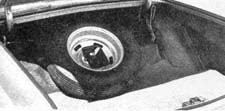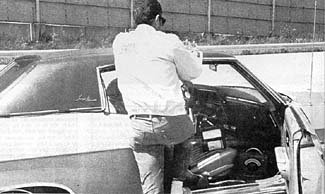

 (Top) An infinite prairie of grass accentuates Impala changes for 1969, including flared wheel wells and ventless side glass. Although Impala sports entirely new sheetmetal, subtle body changes are not immediately apparent. (Above) 1969 trunk space is adequate and similar in size to 1968. Spare is still far forward and difficult to reach for women. (Right) Equipment fills floor and bucket seat. Chevy bucket seats are contoured to fit the back firmly and are extremely comfortable; there is little sliding or swaying in even the tightest corners. |  |
| If you want to test a 1969 Chevrolet
in August ... go to Milford, Mich. and the General Motors Proving Ground. That's where the cars are. Accompanied by security guards and engineers, you can take the one-of-a-kind prototype out and drive it for the day on twisting, curving blacktop roads and at ultra high speed on the long, 3-mile, north/south straightaway.
A completely new body shell with all-new sheetmetal surrounds a virtually unchanged chassis and suspension. Even though the body shell is new, Chevy's big car lines are quite similar to those of 1968. New, scalloped wheel openings, fender skirts, and a convex rear window present an immediate distinctive change in appearance. Other changes sneak up on you more slowly. |
| Powertrain & Performance A 427-c.i.d. engine - that's where it's at if you want a bomb. Add 4-on-the-floor and it's practically a supercar. Not exactly the abstract concept of what the mass of men leading lives of quiet desperation have parked out in the garage. But, to be fair to Chevrolet, it was the only Impala available before production got started. If you want to test a car in August, you take what you can get. Our test car, in addition to the 427-c.i.d. engine with 4-bbl. carburetion, turning out 390 hp., plus the 4-speed manual transmission, was hooked up to |  |
| a 3.31:1 rear axle ratio with positraction. Luckily, a low, low rear end hadn't been included with the package, and performance was more of the family type, with good, nominal engine rpm at highway speeds. With 427 inches and a 4-speed, there was little doubt about acceleration performance, which turned out to be, like fast, as was expected. Chevy's 427 ran smoothly and quietly, even when abused repeatedly with missed speed shifts at high rpms. Four-on-the-floor with a Muncie shifter ... not what the average housewife would clamor for to run the kids to school or make several daily hops to the supermarket. But, if you still enjoy driving a car instead of the other way round, the 4-speed is an ideal adaptation in the Impala. The shifter is located conveniently for comfortable, relaxed driving and doesn't necessitate an overly long reach. We're not exactly in love with the operation of most Muncies, and this one was no exception. Finding second in downshifts wasn't always the easiest thing in the world.
Handling, Steering & Stopping There's not a hell of a lot you can do to change the basic family car suspension from year to year. Chevrolet does employ a platoon of cunning computers now to determine spring rates on each car, for its specific use, which supposedly keeps every car at its designed ride level and trim angle. Suspension on the test Impala had the usual soft sedan feel, but with Chevrolet's unique, inviolate firmness evident in handling and steering. Handling characteristics are good, similar to 1968. Chevy's slightly contoured, resilient bucket seats hold down driver and front seat passenger slipping, sliding, pitching and rolling to a minimum. That fact and cohesive power steering that allows a substantial road feel, gives a mobile smoothness to handling the Impala. Going through tight corners, is always road hugging business. Steering is neutral in normal corners, but aggressive driving brings on built-in understeer. Controlled oversteer occurs in sharp power drifts coming out of turns of less than 90 degrees. On steep, abrupt rises or similar dips, the test car had a tendency, when pushed hard, to bottom mushily, with a rear fender (or some part of the body) hitting noisily. This only happened when the body was twisted considerably in a turn/dip at high speed, and, as this was a prototype, that problem will probably be eliminated in production models. The Chevy, too, was equipped with wide-tread Polyglas tires, which had a noticeable effect on 'handling, steering, and especially stopping. Chevrolet power front disc brakes and drum rear, which our car had, have been a great combination since they were introduced. Stops were always straight and easy to control. Even after repeated use during high-speed acceleration runs (up to 122 mph), there was no fade or burning with the Impala brakes. Comfort, Convenience & Ride Front bucket seats are firm, yet immensely comfortable. Bench seats might be more practical for a family sedan, but there is no compromise with the Chevy buckets. Leg room and pedal placement are also well planned for comfort. A large ashtray in the redesigned instrument panel is easy to reach and use by both driver and passenger, as is the radio, and a hidden ashtray in the center console is an added benefit for heavy smokers. Easy to see and read, a large speedometer/odometer is centrally located behind the steering wheel. The newly designed steering wheel for 1969 is easy to handle and has horn buttons in each side of a padded center bar. Unfortunately, when the bucket seatback on the driver's side is pushed forward for rear seat entry or exit, the seatback head restraint makes perfect contact with the horn buttons and a rather noisy fanfare announces your intention. A design computer must have goofed. Rear seats are comfortable, although seatbacks seem unusually straight. The convex rear window throws lots of light on the rear seat passengers and could become uncomfortably warm if parked in the sun. The window gives unusually good rear-view mirror visibility though. Rear seat knee room is cramped with front buckets all the way back. Headroom in the rear is unusually good and would be adequate for top hats or bouffant hair. Safety seat push buttons are located in the center of front seatbacks and are difficult to find when getting into the back seat. The Chevrolet-Fisher Body combination continues to exemplify quality craftsmanship and construction. This reflects in the ride, that is softly American, yet at the same time surrounds you with adamantine security. Wide Poly tires unquestionably do their part in the excellent ride qualities. Removal of vent windows on the Impala have also added to the feeling of spaciousness in this car, too. Ride is extremely quiet, with little or no wind and road noise. Plus & Minus Features The bottoming body scrape when the suspension gets an unusual amount of activity and the unfortunate match of the steering wheel horn buttons with the front seat head restraint are probably the most outstanding minus features in an otherwise seemingly ideally designed car. More rear seat knee room is needed for good back seat comfort. Ride and handling are primary among plus features. Bucket seat comfort is a close second. Trunk space is more than adequate and should hold a considerable amount of luggage. The trunk, in fact, is so large that the forward located spare is difficult to reach without actually getting into the trunk. Fisher styling still makes the Impala a bon vivant among the big car set. |